ASUS PRO70V, Z83V User Manual
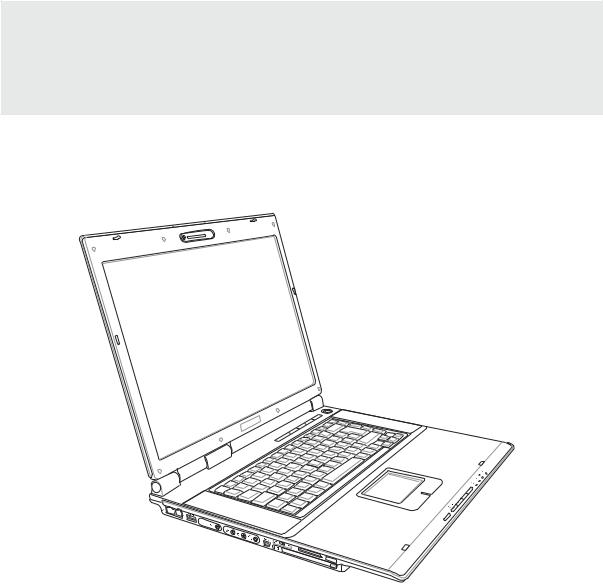
Notebook PC
Hardware User’s Manual
E2106b / Jun 2005

Contents |
|
1. Introducing the Notebook PC .................................................................. |
5 |
About This User’s Manual .......................................................................................... |
6 |
Notes For This Manual .......................................................................................... |
6 |
Preparing your Notebook PC ..................................................................................... |
9 |
2. Knowing the Parts................................................................................... |
11 |
Top Side ................................................................................................................... |
12 |
Bottom Side ............................................................................................................. |
14 |
Left Side ................................................................................................................... |
16 |
Right Side ................................................................................................................ |
18 |
Rear Side ................................................................................................................. |
19 |
Front Side ................................................................................................................ |
20 |
3. Getting Started ....................................................................................... |
21 |
Power System .......................................................................................................... |
22 |
Using AC Power .................................................................................................. |
22 |
Using Battery Power............................................................................................ |
22 |
Charging the Battery Pack .................................................................................. |
22 |
Powering ON the Notebook PC .......................................................................... |
24 |
The Power-On Self Test (POST) ......................................................................... |
24 |
Battery Care ........................................................................................................ |
24 |
Checking Battery Power ...................................................................................... |
25 |
Restarting or Rebooting ...................................................................................... |
26 |
Powering OFF ..................................................................................................... |
26 |
Special Keyboard Functions .................................................................................... |
27 |
Colored Hot Keys ................................................................................................ |
27 |
Keyboard as Cursors........................................................................................... |
28 |
Microsoft Windows™ Keys ................................................................................. |
28 |
Keyboard as a Numeric Keypad ......................................................................... |
29 |
Instant Launch Keys and Status Indicators ............................................................. |
29 |
Instant Launch Keys ............................................................................................ |
29 |
Status Indicators (above keyboard) .................................................................... |
30 |
Status Indicators (front) ....................................................................................... |
31 |
CD Player Control Buttons and Indicator (on selected models) ......................... |
32 |
2

|
Contents |
4. Using the Notebook PC ......................................................................... |
33 |
Operating System .................................................................................................... |
34 |
Support Software................................................................................................. |
34 |
Pointing Device ........................................................................................................ |
34 |
Using the Touchpad ............................................................................................. |
35 |
Touchpad Usage Illustrations .............................................................................. |
36 |
Caring for the Touchpad ...................................................................................... |
37 |
Removing a PC Card (PCMCIA) ......................................................................... |
38 |
Inserting a PC Card (PCMCIA) ........................................................................... |
38 |
Storage Devices....................................................................................................... |
39 |
PC Card (PCMCIA) Socket ................................................................................. |
39 |
Optical Drive ........................................................................................................ |
40 |
Flash Memory Card Reader ................................................................................ |
42 |
Modem Connection ............................................................................................. |
42 |
Hard Disk Drive ................................................................................................... |
43 |
Network Connection ............................................................................................ |
44 |
Power Savings .................................................................................................... |
45 |
Power Management Modes ..................................................................................... |
45 |
Full Power Mode & Maximum Performance........................................................ |
45 |
ACPI .................................................................................................................... |
45 |
Suspend Mode .................................................................................................... |
45 |
Power State Summary ........................................................................................ |
46 |
Thermal Power Control ....................................................................................... |
46 |
Stand by and Hibernate....................................................................................... |
47 |
Multimedia Connections (on selected models) ........................................................ |
48 |
Audio/Video Remote Controller (on selected models) ........................................ |
49 |
Appendix ..................................................................................................... |
51 |
Optional Accessories ............................................................................................... |
52 |
Optional Connections............................................................................................... |
55 |
Glossary ................................................................................................................... |
56 |
Declarations and Safety Statements ....................................................................... |
60 |
Notebook PC Information......................................................................................... |
72 |
3
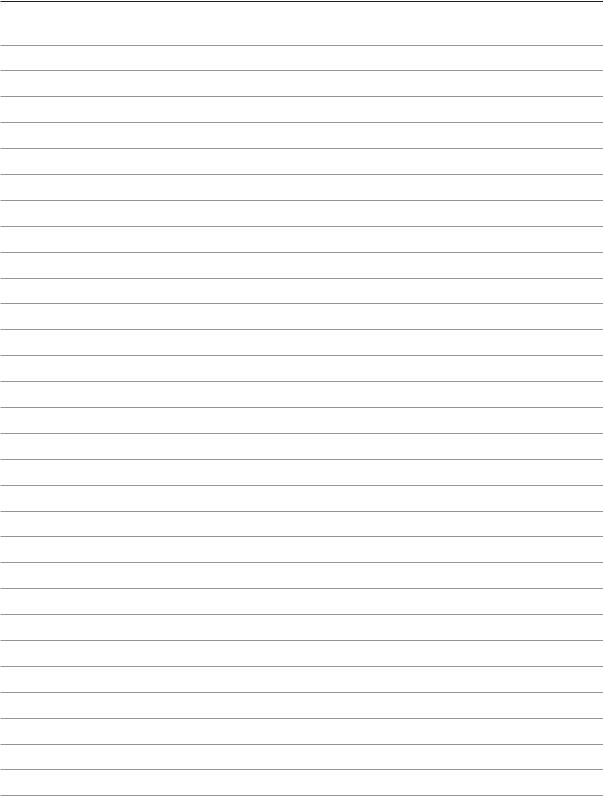
Contents
4
1. Introducing the Notebook PC
About This User’s Manual
Notes For This Manual
Safety Precautions
Preparing your Notebook PC
5
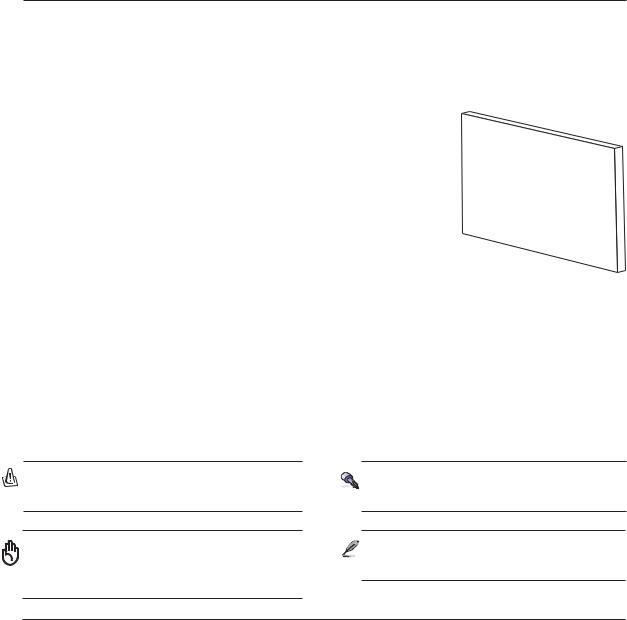
1 Introducing the Notebook PC
About This User’s Manual
You are reading the Notebook PC User’s Manual. This User’s Manual provides information on the various components in the Notebook PC and how to use them. The following are major sections of this User’s Manuals:
1.Introducing the Notebook PC
Introduces you to the Notebook PC and this User’s Manual.
2.Knowing the Parts
Gives you information on the Notebook PC’s components.
3.Getting Started
Gives you information on getting started with the Notebook PC.
4.Using the Notebook PC
Gives you information on using the Notebook PC’s components.
5.Appendix
Introduces you to optional accessories and gives additional information.
User’s |
Manual |
|
Notes For This Manual
A few notes and warnings in bold are used throughout this guide that you should be aware of in order to complete certain tasks safely and completely. These notes have different degrees of importance as described below:
WARNING! Important information that must be followed for safe operation.
IMPORTANT! Vital information that must be followed to prevent damage to data, components, or persons.
TIP: Tips and useful information for completing tasks.
NOTE: Tips and information for special situations.
< > |
Text enclosed in < > or [ ] represents a key on the keyboard; do not actually type the |
[ ] |
< > or [ ] and the enclosed letters. |
|
|
6
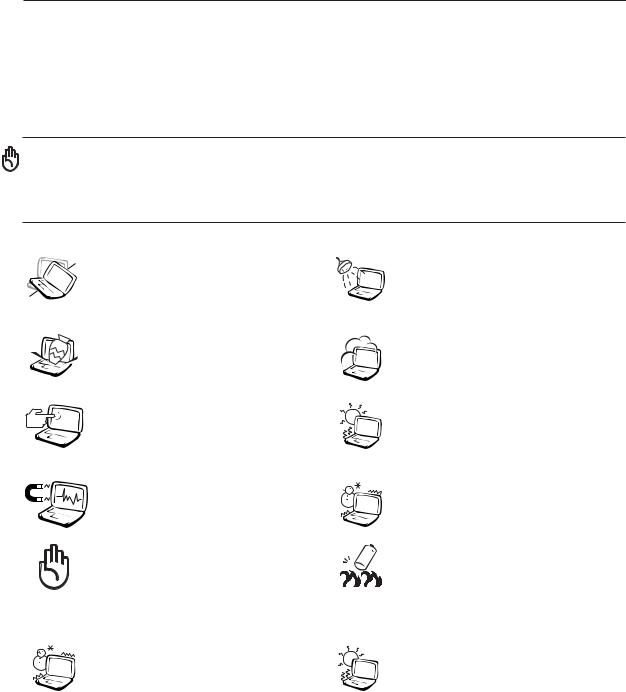
Introducing the Notebook PC 1
Safety Precautions
The following safety precautions will increase the life of the Notebook PC. Follow all precautions and instructions. Except as described in this manual, refer all servicing to qualified personnel. Do not use damaged power cords, accessories, or other peripherals. Do not use strong solvents such as thinners, benzene, or other chemicals on or near the surface.
Disconnect the AC power and remove the battery pack(s) before cleaning. Wipe the Notebook PC using a clean cellulose sponge or chamois cloth dampened with a solution of nonabrasive detergent and a few drops of warm water and remove any extra moisture with a dry cloth.
DO NOT place on uneven or unstable work surfaces. Seek servicing if the casing has been damaged.
DO NOT place or drop objects on top and do not shove any foreign objects into the Notebook PC.
DO NOT press or touch the display panel. Do not place together with small items that may scratch or enter the Notebook PC.
DO NOT expose to strong magnetic or electrical fields.
DO NOT leave the Notebook PC on your lap or any part of the body while the Notebook PC is turned ON or is charging in order to prevent discomfort or injury from heat exposure.
Safe Operating Temperatures: This |
|
notebook PC should be used in envi- |
|
ronments with ambient temperatures |
30°C/86°F |
0°C/32°F between 0°C/32°F and 30°C/86°F. |
DO NOT expose to or use near liquids, rain, or moisture. DO NOT use the modem during an electrical storm.
DO NOT expose to dirty or dusty environments. DO NOT operate during a gas leak.
DONOTexposetoextremetemperatures above 50˚C (122˚F) or to direct sunlight. Do not block the fan vents!
DO NOT expose to extreme temperatures (below 0˚C (32˚F), otherwise the Notebook PC may not boot.
DO NOT throw batteries in fires as they may explode. Check local codes for special battery disposal instructions.
7
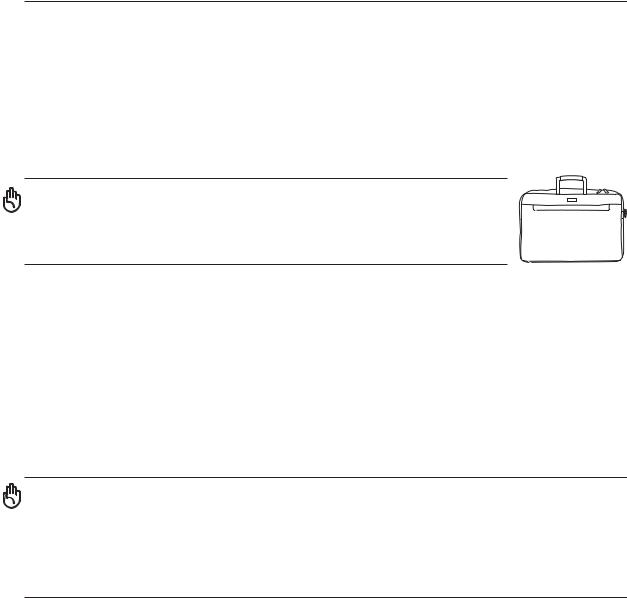
1 Introducing the Notebook PC
 Transportation Precautions
Transportation Precautions
To prepare the Notebook PC for transport, you should turn it OFF and disconnect all external peripherals to prevent damage to the connectors. The hard disk drive’s head retracts when the power is turned OFF to prevent scratching of the hard disk surface during transport. Therefore, you should not transport the Notebook PC while the power is still ON. Close the display panel and check that it is latched securely in the closed position to protect the keyboard and display panel.
Cover Your Notebook PC
CAUTION: The Notebook PC’s surface is easily dulled if not properly cared for. Be careful not to rub or scrape the Notebook PC surfaces  when transporting your Notebook PC. You can purchase an optional carrying case to protect it from dirt, water, shock, and scratches.
when transporting your Notebook PC. You can purchase an optional carrying case to protect it from dirt, water, shock, and scratches.
 Charge Your Batteries
Charge Your Batteries
If you intend to use battery power, be sure to fully charge your battery pack and any optional battery packs before going on long trips. Remember that the power adapter charges the battery pack as long as it is plugged into the computer and an AC power source. Be aware that it takes much longer to charge the battery pack when the Notebook PC is in use.
 Airplane Precautions
Airplane Precautions
Contact your airline if you want to use the Notebook PC on the airplane. Most airlines will have restrictions for using electronic devices. Most airlines will allow electronic use only between and not during takeoffs and landings.
CAUTION! There are three main types of airport security devices: X-ray machines (used on items placed on conveyor belts), magnetic detectors (used on people walking through security checks), and magnetic wands (hand-held devices used on people or individual items). You can send your Notebook PC and diskettes through airport X- ray machines. However, it is recommended that you do not send your Notebook PC or diskettes through airport magnetic detectors or expose them to magnetic wands.
8
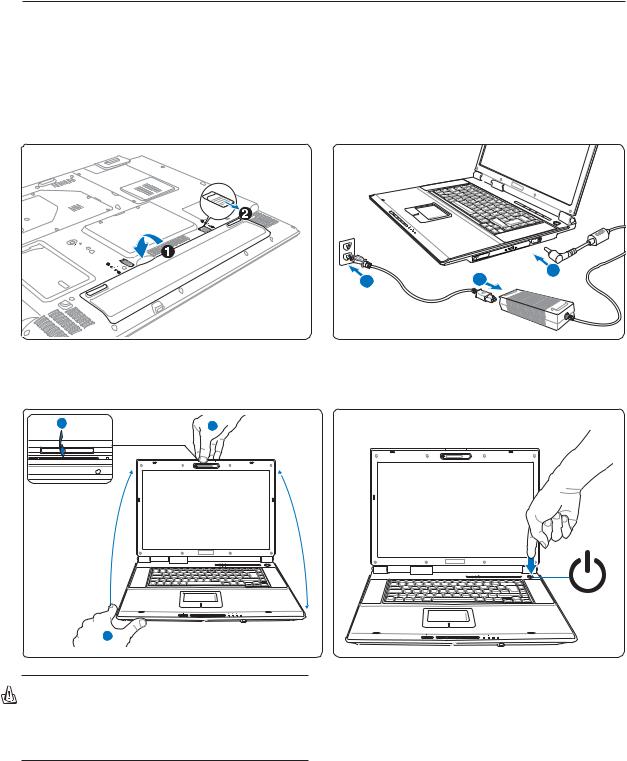
Introducing the Notebook PC 1
Preparing your Notebook PC
These are only quick instructions for using your Notebook PC. Read the later pages for detailed information on using your Notebook PC.
1. Install the battery pack |
2. Connect the AC Power Adapter |
3
2 |
1 |
3. Open the Display Panel |
4. Turn ON the Notebook PC |
|
2 |
3 |
|
1 |
PREY. |
NEXT |
STOP |
PLAY/PAUSE |
WARNING! When opening, do not force the display panel down to the table or else the hinges may break! Never lift the Notebook PC by the display panel!
Press the power button and release.
(In Windows XP, this button can also be used to safely turn OFF the Notebook PC.)
9
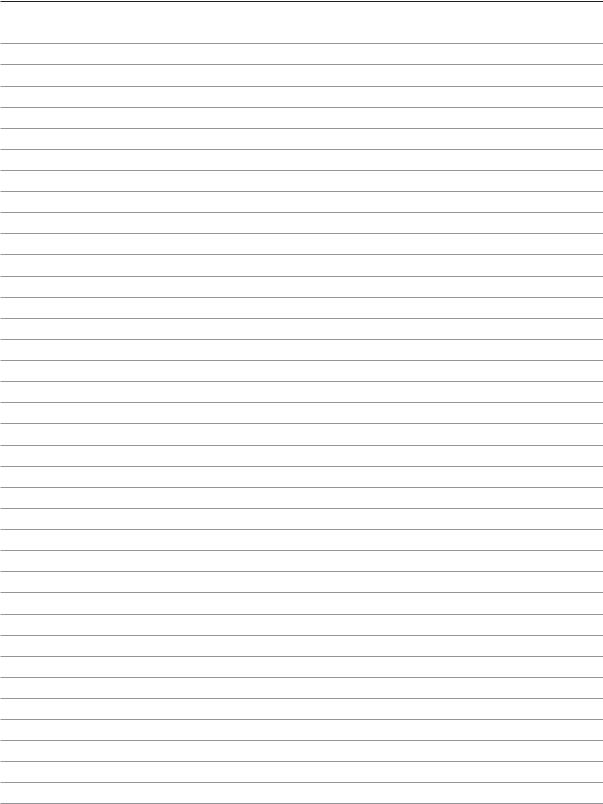
1 Introducing the Notebook PC
10
2. Knowing the Parts
Basic sides of the Notebook PC
11
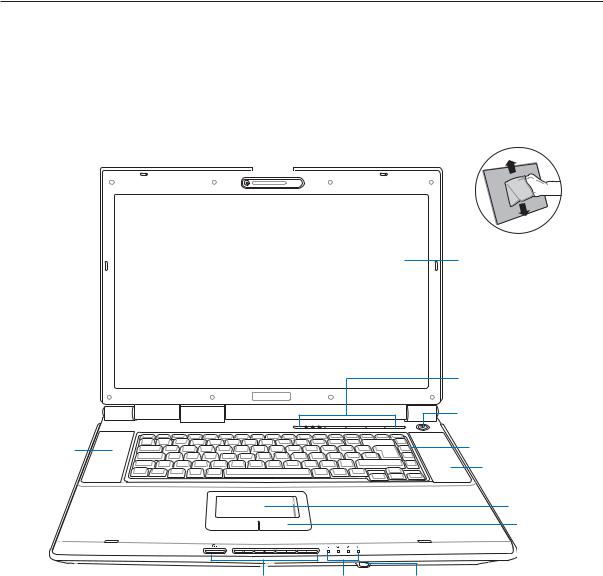
2 Knowing the Parts
Top Side
Refer to the diagram below to identify the components on this side of the Notebook PC. Details are given starting from the top and going clockwise.
|
Display panel |
||||||
Camera |
|
|
latch |
||||
(on selected models) |
|
|
|
|
|
|
Microphone |
|
|
|
|
|
|
||
|
|
|
|
|
|
|
|
|
|
|
|
|
|
|
|
|
|
|
|
|
|
|
|
Display Panel (Use a soft cloth without chemical liquids to clean. Use plain water if necessary.)
Status Indicators
Instant Keys (see section 3)
Power Switch
Stereo Speaker
Stereo Speaker
Touchpad
Touchpad buttons
PREV NEXT STOP PLAY/PAUSE
CD Player Control |
Status Indicators |
CIR Port |
(on selected models) |
(see section 3) |
(see front side) |
(see section 3) |
|
|
12

Knowing the Parts 2
 Camera (on selected models)
Camera (on selected models)
The built-in camera allows picture taking or video recording. Can be used with voice conferencing and other interactive applications.
 Microphone
Microphone
The built-in mono microphone can be used for video conferencing, voice narrations, or simple audio recordings.
 Display Panel
Display Panel
The display panel functions the same as a desktop monitor. The Notebook PC uses an active matrix TFT LCD, which provides excellent viewing like that of desktop monitors. Unlike desktop monitors, the LCD panel does not produce any radiation or flickering, so it is easier on the eyes.
 Power Switch
Power Switch
The power switch allows powering ON and OFF the Notebook PC and recovering from STD. Push the switch once to turn ON and once to turn OFF the Notebook PC. The power switch only works when the display panel is opened.


 Keyboard
Keyboard
The keyboard provides full-sized keys with comfortable travel (depth at which the keys can be depressed) and palm rest for both hands. Two Windows™ function keys are provided to help ease navigation in the Windows™ operating system.

 Touchpad and Buttons
Touchpad and Buttons
The touchpad with its buttons is a pointing device that provides the same functions as a desktop mouse. A software-controlled scrolling function is available after setting up the included touchpad utility to allow easy Windows or web navigation.
13
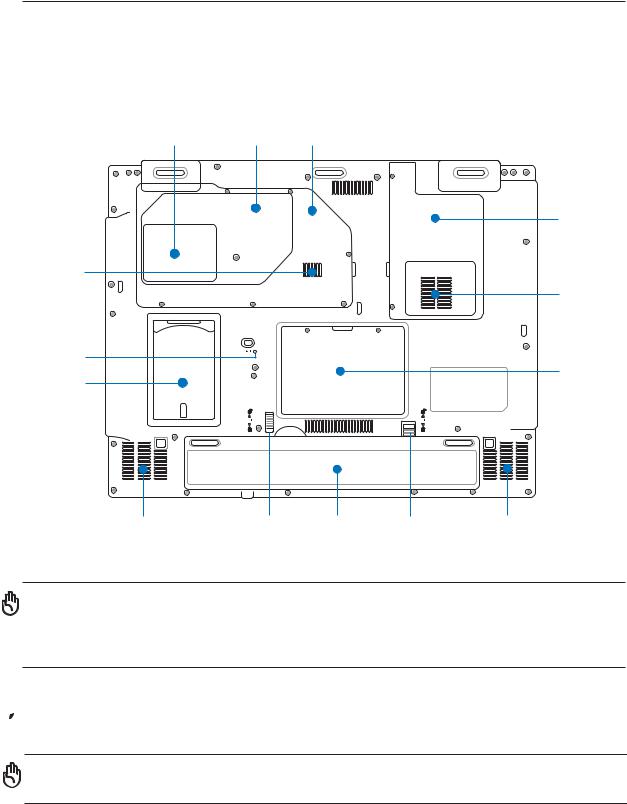
2 Knowing the Parts
Bottom Side
Refer to the diagram below to identify the components on this side of the Notebook PC. Details are given starting from the top and going clockwise. Some labels identify components inside removable panels.
Cooling Fan |
CPU VGA Chipset |
|
WLAN |
|
Expansion Slot |
Memory |
|
Slot |
|
|
TV Tuner |
|
Expansion Slot |
Emergency |
|
Shutdown |
|
Button |
Hard Disk |
Name card |
Drive |
holder |
|
|
2 |
Stereo |
Spring |
Battery |
Battery |
Stereo |
Speaker |
Battery Lock |
Pack |
Lock |
Speaker |
IMPORTANT! The bottom of the Notebook PC can get very hot. Be careful when handling the Notebook PC while it is in operation or recently been in operation. High temperatures are normal during charging or operation. DO NOT PUT THE NOTEBOOK PC ON THE LAP OR OTHER PARTS OF THE BODY TO AVOID INJURY FROM THE HEAT.

 Air Vents
Air Vents
The air vents allow cool air to enter and warm air to exit the Notebook PC.
IMPORTANT! Make sure that paper, books, clothing, cables, or other objects do not block any of the air vents or else overheating of the Notebook PC may occur.
14

Knowing the Parts 2
 Central Processor (CPU)
Central Processor (CPU)
Some Notebook PC models feature a socketed-processor design to allow upgrading to faster processors in the future. Some models feature a ULV design for compactness and may not be upgraded. Visit an authorized service center or retailer for information on upgrades.
WARNING! End-user removal of the CPU or hard disk drive will void the warranty.
 TV Tuner / WLAN Expansion Slots
TV Tuner / WLAN Expansion Slots
The TV tuner slot can accommodate a TV tuner card in order to watch television programs on the Notebook PC. The WLAN expansion slot can accomodate a wireless networking card in order to wirelessly connect to network access points and the Internet.
 Hard Disk Drive
Hard Disk Drive
The hard disk drive is secured in a compartment. Hard disk drive upgrades are to be done by authorized service centers or dealers only.
 Stereo Speakers
Stereo Speakers
The built-in stereo speaker system allows you to hear audio without additional attachments. The multimedia sound system features an integrated digital audio controller that produces rich, vibrant sound (results improved with external stereo headphones or speakers). Audio features are software controlled.
 Battery Lock
Battery Lock
The battery lock is used to keep the battery pack secured. Usage details are described in the battery section later in this manual.
 Battery Pack
Battery Pack
The battery pack is automatically charged when connected to an AC power source and maintains power to the Notebook PC when AC power is not connected. This allows use when moving temporarily between locations. Battery time varies by usage and by the specifications for this Notebook PC. The battery pack cannot be disassembled and must be replaced as a single unit through an authorized vendor.

 Emergency Shutdown Button
Emergency Shutdown Button
In case your operating system cannot properly turn OFF or restart, the shutdown button can be pressed with a straightened paper clip to shutdown the Notebook PC.



 Memory Slot
Memory Slot
The memory compartment contains an expansion slot for additional memory. Memory installation or upgrades must be done by an authorized retailer or else warranty will be void.
15
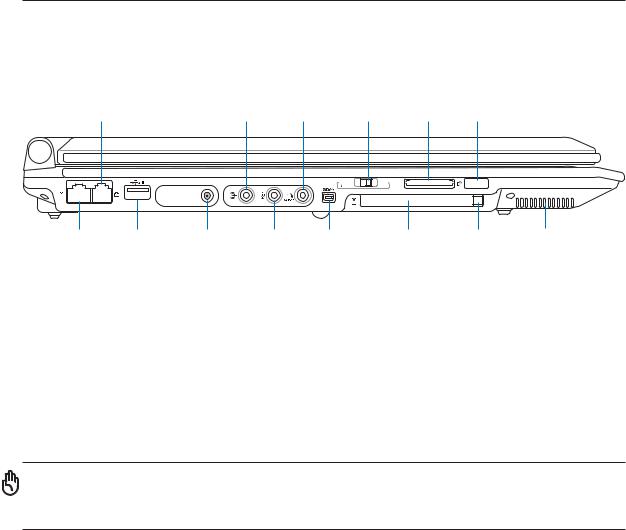
2 Knowing the Parts
Left Side
Refer to the diagram below to identify the components on this side of the Notebook PC.
Modem |
Audio |
SPDIF/ |
WLAN |
Flash |
Infrared |
Phone |
|||||
Port |
Input |
Output |
ON/OFF |
Memory Slot |
Port |
 ON OFF
ON OFF
FM/DTV/CATV
LAN |
USB Port |
Antenna Input |
Mic |
1394 |
PC Card |
PC Card |
Stereo Speaker |
Port |
(see rear side) |
(on selected model) |
Input |
Port |
Slot |
Eject |
(see bottom side) |
 LAN Port
LAN Port
The RJ-45 LAN port with eight pins is larger than the RJ-11 modem port and supports a standard Ethernet cable for connection to a local network. The built-in connector allows convenient use without additional adapters.
 Modem Port
Modem Port
The RJ-11 modem port with two pins is smaller than the RJ-45 LAN port and supports a standard telephone cable. The internal modem supports up to 56K V.90 transfers. The built-in connector allows convenient use without additional adapters.
IMPORTANT! The built-in modem does not support the voltage used in digital phone systems. Do not connect the modem port to a digital phone system or else damage will occur to the Notebook PC.

 Antenna Input
Antenna Input
The antenna input is for TV or FM Radio (on selected models) frequency signal and allows for use with the provided digital TV/FM antenna or input from subscription television services. The provided antenna can receive digital TV or FM radio. Cable service connection can receive digital TV, analog TV, or FM radio depending on paid services. The provided adapter is necessary to change the coaxial plug to fit the slim Notebook PC.
 Audio Input Jack (Audio In)
Audio Input Jack (Audio In)
The stereo input jack (1/8 inch) can be used to connect a stereo audio source to the Notebook PC. This feature is used mainly to add audio to multimedia applications.
16

Combo
Knowing the Parts 2
 Microphone Input Jack (Mic In)
Microphone Input Jack (Mic In)
The mono microphone jack (1/8 inch) can be used to connect an external microphone or output signals from audio devices. Using this jack automatically disables the built-in microphone. Use this feature for video conferencing, voice narrations, or simple audio recordings.


 SPDIF Output Jack (SPDIF Output)
SPDIF Output Jack (SPDIF Output)
This jack provides connection to SPDIF (Sony/Philips Digital Interface) compliant devices for digital audio output. Use this feature to turn the Notebook PC into a hi-fi home entertainment system.

 Headphone Output Jack (Phone Output)
Headphone Output Jack (Phone Output)
The stereo headphone jack (1/8 inch) is used to connect the Notebook PC’s audio out signal to amplified speakers or headphones. Using this jack automatically disables the built-in speakers.

 1394 Port
1394 Port
IEEE1394 is a high speed serial bus like SCSI but has simple connections and hot-plugging capabilities like USB. The interface IEEE1394 has a bandwidth of 100-400 Mbits/sec and can handle up to 63 units on the same bus. IEEE1394 is also used in high-end digital equipment and should be marked “DV” for Digital Video port.
 Flash Memory Slot
Flash Memory Slot
Normally a PCMCIA or USB memory card reader must be purchased separately in order to use memory cards from devices such as digital cameras, MP3 players, mobile phones, and PDAs. This Notebook PC has a built-in memory card reader that can read many flash memory cards as specified later in this manual. The built-in memory card reader is not only convenient, but also faster than most other forms of memory card readers because it utilizes the high-bandwidth PCI bus.
 Infrared Port (IrDA)
Infrared Port (IrDA)
The infrared (IrDA) communication port allows convenient wireless data communication with infraredequipped devices or computers. This allows easy wireless synchronization with PDAs or mobile phones and even wireless printing to printers. If your office supports IrDA networking, you can have wireless connection to a network anywhere provided there is a direct line of sight to an IrDA node. Small offices can use IrDA technology to share a printer between several closely placed Notebook PCs and even send files to each other without a network.
 PC Card Slot
PC Card Slot
One PCMCIA 2.1 compliant PC Card socket is available to support one type I/II PC card. The socket supports 32-bit CardBus. This allows accommodation of Notebook PC expansion options such as memory cards, ISDN, SCSI, Smart Cards, and wireless network adapters.
17
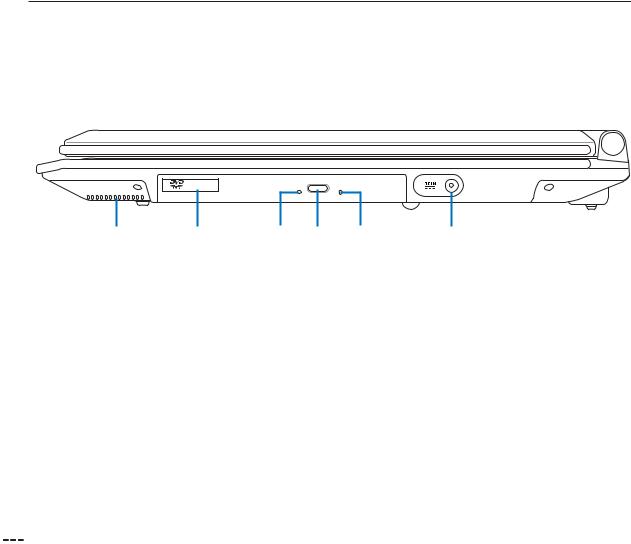
2 Knowing the Parts
Right Side
Refer to the diagram below to identify the components on this side of the Notebook PC.
Stereo Speaker |
Optical Drive |
Activity |
Electronic Emergency |
Power |
|
(see bottom side) |
(varies by model) |
Indicator |
Eject |
Eject |
Input |
 Optical Drive
Optical Drive
The Notebook PC comes in various models with different optical drives. The Notebook PC’s optical drive may support compact discs (CD) and/or digital video discs (DVD) and may have recordable (R) or re-writable (RW) capabilities. See the marketing specifications for details on each model.
 Electronic Eject, Emergency Eject (Optical Drive)
Electronic Eject, Emergency Eject (Optical Drive)
The optical drive eject has an electronic eject button for opening the tray. You can also eject the optical drive tray through any software player or by right clicking the optical drive in Windows™ “My Computer.” The emergency eject is used to eject the optical drive tray in case the electronic eject does not work. Do not use the emergency eject in place of the electronic eject. The activity LED (not available on some models) lights in proportion to the data transferred between the Notebook PC and optical disc.
 Power (DC) Input
Power (DC) Input
The supplied power adapter converts AC power to DC power for use with this jack. Power supplied through this jack supplies power to the Notebook PC and charges the internal battery pack. To prevent damage to the Notebook PC and battery pack, always use the supplied power adapter.
18
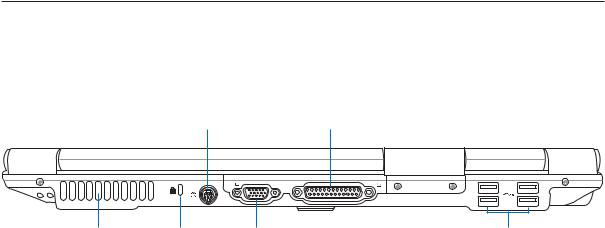
Knowing the Parts 2
Rear Side
Refer to the diagram below to identify the components on this side of the Notebook PC.
TV-Out Port |
Parallel Port |
Cooling Fan |
Kensington® |
Display |
USB |
and Air Vents |
Lock Port |
Output |
Ports |
 Kensington® Lock Port
Kensington® Lock Port
The Kensington® lock port allows the Notebook PC to be secured using Kensington® compatible Notebook PC security products. These security products usually include a metal cable and lock that prevent the Notebook PC to be removed from a fixed object. Some security products may also include a motion detector to sound an alarm when moved.

 TV-Out Port
TV-Out Port
The TV-Out port is an S-Video connector that allows routing the Notebook PC’s display to a television or video projection device. You can choose between simultaneouly or single display. Use an S-Video cable (not provided) for high quality displays or use the provided RCA to S-Video adapter for standard video devices. This port supports both NTSC and PAL formats.
 Display (Monitor) Output
Display (Monitor) Output
The 15-pin D-sub monitor port supports a standard VGA-compatible device such as a monitor or projector to allow viewing on a larger external display.
 Parallel Port
Parallel Port
The 25-pin D-sub parallel/printer port supports native parallel devices such as laser/inkjet printers, or parallel-adapted device such as external hard drives, removable drives, or scanners.
 2.0 USB Port (2.0/1.1)
2.0 USB Port (2.0/1.1)
The Universal Serial Bus is compatible with USB 2.0 or USB 1.1 devices such as keyboards, pointing devices, video cameras, modems, hard disk drives, printers, monitors, and scanners connected in a series up to 12Mbits/sec (USB 1.1) and 480Mbits/sec (USB 2.0). USB allows many devices to run simultaneously on a single computer, with peripherals such as USB keyboards and some newer monitors acting as additional plug-in sites or hubs. USB supports hot-swapping of devices so that peripherals can be connected or disconnected without restarting the computer.
19

2 Knowing the Parts
Front Side
Refer to the diagram below to identify the components on the front side of the Notebook PC.
|
|
Display panel latch |
|
|
|
CIR Port |
|
||||
|
|
|
(on selected models) |
|
|||||||
|
|
|
|
|
|
|
|
|
|
|
|
|
|
|
|
|
|
|
|
|
|
|
|
|
|
|
|
|
|
|
|
|
|
|
|
|
|
|
|
|
|
|
|
|
|
|
|
|
|
|
|
|
|
|
|
|
|
|
|
|
|
|
|
|
|
|
|
|
|
|
|
|
|
|
|
|
|
|
|
|
|
|
|
|
|
|
|
|
|
|
|
|
|
|
|
CD Player Control |
Status Indicators |
(see section 3) |
(see section 3) |
 Display Panel Latch
Display Panel Latch
One spring-loaded latch on the front of the Notebook PC locks the display panel in the closed position when the Notebook PC is not in use. To open the display panel, press the latch with your thumb and lift up the display panel with the same thumb. Slowly tilt the display panel forward or backward to a comfortable viewing angle.
 CIR Port (Consumer Infrared) (on selected models)
CIR Port (Consumer Infrared) (on selected models)
The consumer infrared (IrDA) communication port allows convenient wireless control of the provided multimedia software in selected models using the provided wireless remote control in selected models.
20
3. Getting Started
Using AC Power
Using Battery Power
Powering ON the Notebook PC Checking Battery Power Restarting or Rebooting Powering OFF the Notebook PC Special Keyboard Functions Instant Keys and Status Indicators
21
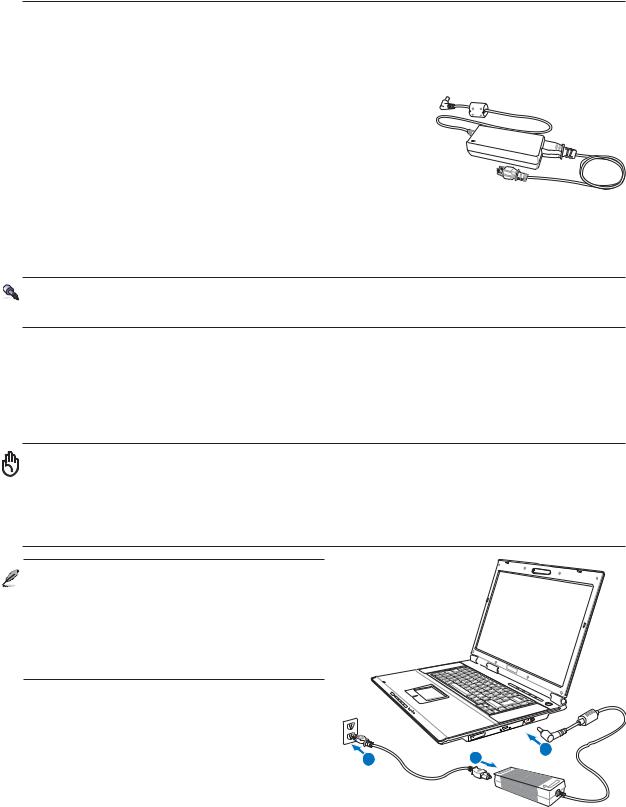
3 Getting Started
Power System


 Using AC Power
Using AC Power
The Notebook PC power is comprised of two parts, the power adapter and the battery power system. The power adapter converts AC power
from a wall outlet to the DC power required by the Notebook PC.
Your Notebook PC comes with a universal AC-DC adapter. That means that you may connect the power cord to any 100V-120V as
well as 220V-240V outlets without setting switches or using power
converters. Different countries may require that an adapter be used to connect the provided US-standard AC power cord to a different standard. Most hotels will provide universal outlets to support different power cords as well as voltages. It is always best to ask an experienced traveler about AC outlet voltages when bringing power adapters to another country.
TIP: You can buy travel kits for the Notebook PC that includes power and modem adapters for almost every country.
With the AC power cord connected to the AC-DC converter, connect the AC power cord to an AC outlet (preferably with surge-protection) and then connect the DC plug to the Notebook PC. Connecting the AC-DC adapter to the AC outlet first allows you to test the AC outlet’s power and the AC-DC converter itself for compatibility problems before connecting the DC power to the Notebook PC. The green power LED on the adapter lights up if the power is within accepted ranges.
IMPORTANT! Damage may occur if you use a different adapter to power the Notebook PC or use the Notebook PC’s adapter to power other electrical devices. If there is smoke, burning scent, or extreme heat coming from the AC-DC adapter, seek servicing. Seek servicing if you suspect a faulty AC-DC adapter. You may damage both your battery pack(s) and the Notebook PC with a faulty AC-DC adapter.
NOTE: This Notebook PC may come with either a two or three-prong plug depending on territory. If a three-prong plug is provided, you must use a grounded AC outlet or use a properly grounded adapter to ensure safe operation of the Notebook PC.
3
2 |
1 |
22
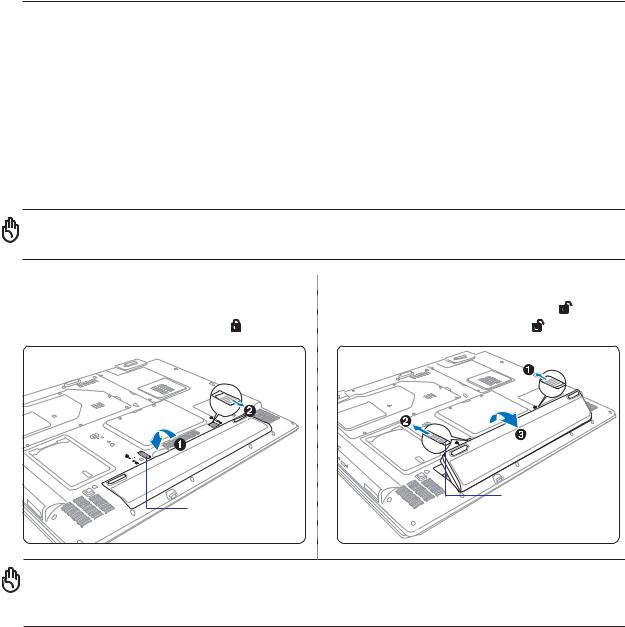
Getting Started 3
 Using Battery Power
Using Battery Power
The Notebook PC is designed to work with a removable battery pack. The battery pack consists of a set of battery cells housed together. A fully charged pack will provide several hours of battery life, which can be further extended by using power management features through the BIOS setup. Additional battery packs are optional and can be purchased separately through a Notebook PC retailer.
Installing and Removing the Battery Pack
Your Notebook PC may or may not have its battery pack installed. If your Notebook PC does not have its battery pack installed, use the following procedures to install the battery pack.
IMPORTANT! Never attempt to remove the battery pack while the Notebook PC is turned ON, as this may result in the loss of working data.
To install the battery pack: |
To remove the battery pack: |
|
1. Insert the battery pack as shown. |
1. |
Slide the battery lock to the unlock position. |
2. Slide the battery lock to the lock position. |
2. |
Slide the spring lock to unlock and hold. |
Spring Lock
Spring Lock
IMPORTANT! Only use battery packs and power adapters supplied with this Notebook PC or specifically approved by the manufacturer or retailer for use with this model or else damage may occur to the Notebook PC.
 Charging the Battery Pack
Charging the Battery Pack
Before you use your Notebook PC on the road, you will have to charge the battery pack. The battery pack begins to charge as soon as the Notebook PC is connected to external power using the power adapter. Fully charge the battery pack before using it for the first time. Anew battery pack must completely charge before the Notebook PC is disconnected from external power. It takes a few hours to fully charge the battery when the Notebook PC is turned OFF and may take twice the time when the Notebook PC is turned ON. The battery charge light turns OFF when the battery pack is charged.
23
